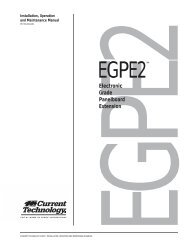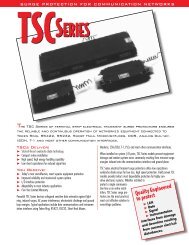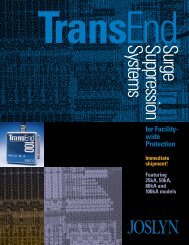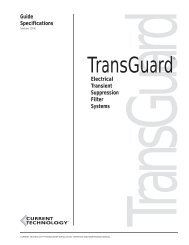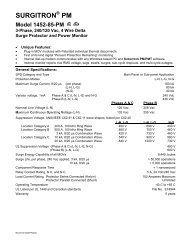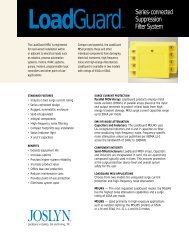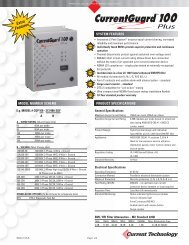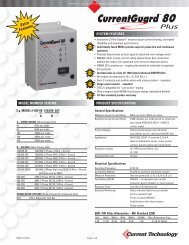overview PDF - Power & Systems Innovations
overview PDF - Power & Systems Innovations
overview PDF - Power & Systems Innovations
Create successful ePaper yourself
Turn your PDF publications into a flip-book with our unique Google optimized e-Paper software.
SF 150<br />
MEDIUM EXPOSURE PROTECTION<br />
S U P P R E S S I O N F I L T E R S Y S T E M<br />
Compatible with all Current Technology MasterPLAN ® facility-wide suppression filter system products<br />
T E C H N I C A L D A T A S H E E T<br />
STANDARD MODEL NUMBERS<br />
SF150-120/240-2G SF150-120/240-3GHD<br />
SF150-120/208-3GY SF150-240-3D<br />
SF150-277/480-3GY SF150-480-3D<br />
SF150-347/600-3GY SF150-600-3D<br />
Contact factory for other voltages and configurations. Add option suffix(es) as required.<br />
SINGLE PULSE SURGE CURRENT CAPACITY<br />
Protection<br />
mode<br />
Single pulse surge<br />
current capacity per mode<br />
Line-to-Neutral<br />
> 150,000 A<br />
Line-to-Ground<br />
> 150,000 A<br />
Neutral-to-Ground > 150,000 A<br />
Line-to-Line<br />
> 150,000 A<br />
Per Phase<br />
> 300,000 A<br />
In compliance with NEMA LS 1-1992, paragraphs 2.2.7, 2.2.9 and 3.9, Current Technology suppression<br />
filter systems are single pulse surge current tested in all modes at currents up to 150% of the product<br />
design rating by an industry-recognized independent test laboratory. Single pulse surge current<br />
capacities of 200,000 amps or less are established by single-unit testing of all components within each<br />
mode. Due to present industry test equipment limitations, single pulse surge current capacities over<br />
200,000 amps are established via testing of individual components or sub-assemblies within a mode.<br />
REPETITIVE SURGE CURRENT CAPACITY<br />
Protection<br />
mode<br />
Minimum tested impulses<br />
per mode<br />
Line-to-Neutral > 5,000<br />
Line-to-Ground > 5,000<br />
Neutral-to-Ground > 5,000<br />
Line-to-Line > 5,000<br />
Per ANSI/IEEE C62.41-1991 and ANSI/IEEE C62.45-1992, all Current Technology suppression filter systems<br />
are repetitive surge current capacity tested in every mode utilizing a 1.2 X 50 µsec 20KV open<br />
circuit voltage, 8 X 20 µsec 10 KA short circuit current Category C3 bi-wave at one minute intervals<br />
without suffering either performance degradation or more than 10% deviation of clamping voltage at<br />
a specified surge current.<br />
EMI/RFI NOISE REJECTION VALUES<br />
Multiple unit Frequency Single unit<br />
installation<br />
installation<br />
51 dB 100 KHz 34 dB<br />
94 dB 1 MHz 51 dB<br />
114 dB 10 MHz 54 dB<br />
120 dB 100 MHz 48 dB<br />
All Current Technology suppression filter systems EMI-RFI noise rejection or attenuation values are in<br />
compliance with test and evaluation procedures outlined in NEMA LS 1-1992, paragraphs 2.2.11 and 3.11.<br />
MAXIMUM CONTINUOUS OPERATING VOLTAGE (MCOV)<br />
Voltage MCOV Voltage MCOV<br />
120V 150V 347V 420V<br />
240V 275V 480V 640V<br />
277V 320V 600V 840V<br />
All Current Technology suppression filter systems maximum continuous operating voltages are in compliance<br />
with test and evaluation procedures outlined in NEMA LS 1-1992, paragraphs 2.2.6 and 3.6.<br />
TYPICAL CLAMPING VOLTAGE DATA<br />
Voltage<br />
Protection A3 B3 B3/C1 C3<br />
mode RingwaveRingwave Comb.WaveComb.Wave<br />
L-N 210/250 260/310 380/430 470/800<br />
L-G 340/360 360/430 370/420 440/800<br />
N-G 240/240 290/290 400/400 575/575<br />
L-L 360/450 480/550 690/780 780/1450<br />
L-N 420/470 470/510 800/840 950/1200<br />
L-G 750/780 750/800 750/800 860/1100<br />
N-G 520/520 600/600 800/800 1000/1000<br />
L-L 700/800 820/900 1480/1550 1660/2000<br />
120 / 208<br />
277 / 480<br />
All Current Technology suppression filter systems clamping voltages are in compliance with test and<br />
evaluation procedures outlined in NEMA LS 1-1992, paragraphs 2.210 and 3.10. Values following slash<br />
(/) indicate typical clamping voltage data for models with integral fused disconnect (DF) option.<br />
MECHANICAL SPECIFICATIONS<br />
Connection method Parallel<br />
Enclosure type/mount NEMA 4X/surface<br />
Temperature operating range -40˚C to 60˚C<br />
Humidity operating range 5% - 95% non-condensing<br />
Dimensions without options 15.69”H x 12.40”W x 7.94”D<br />
Dimensions with options 20.18”H x 16.24”W x 8.95”D<br />
Weight without options 30 lbs.<br />
Weight with options 49 lbs.<br />
STANDARD FEATURES<br />
Suppression filter seamless technology <br />
technology<br />
Internal All suppression filter components are<br />
construction bolted to corrosion-resistant tin-plated<br />
copper bus bar<br />
Status indicators Neon status indicators indicate<br />
suppression and overcurrent status<br />
Test point Diagnostic ten mode test point allows<br />
easy DTS-2 Diagnostic Test Set connection<br />
Standards UL 1449, UL 1283, CUL, NEMA LS 1<br />
Warranty Five Years<br />
OPTIONS<br />
Option<br />
Suffix<br />
Fused disconnect<br />
-DF<br />
Double form “C” dry contacts<br />
-FCC<br />
StatusWatch diagnostic monitoring -SW<br />
StatusWatch with display event counters -SWC<br />
DTS-2 Diagnostic Test Set<br />
-DTS<br />
Remote StatusWatch <br />
-RSW<br />
Remote StatusWatch with Counters -RSWC<br />
Remote Alarm Panel (Monitors 1 unit) -RAP1<br />
Remote Alarm Panel (Monitors 1 – 5 units) -RAP5<br />
Remote Alarm Panel (Monitors 1 – 12 units) -RAP12<br />
All Status Watch options include double form “C” dry contacts,<br />
audible alarm, alarm silence/test and status indicator lights.
SF150 INSTALLATION<br />
INSTRUCTIONS<br />
1. Voltage Verification<br />
Prior to product installation, verify that the voltage rating of the intended<br />
electrical service matches the voltage rating of the unit to be installed.<br />
Warning: serious injury or damage can result from installing a product<br />
with an improper voltage rating. Contact Current Technology if voltage ratings<br />
are not identical. For WYE connected systems, verify neutral-ground<br />
bond on secondary side of upstream distribution or service entrance transformer.<br />
Warranty void if SF150 is connected to incorrect voltage configuration<br />
or if neutral-ground bond is not present in WYE configured systems.<br />
2. Installation Location<br />
To minimize installed system impedance, install SF150 in a location that minimizes<br />
electrical wire bends and wiring distance from point of connection.<br />
3. Mounting<br />
Utilizing the mounting feet and hardware supplied with the unit, mount the<br />
SF150 securely and rigidly to building surface or structural member. Attach<br />
conduit and pull wires as necessary.<br />
4. Electrical Connections<br />
VERIFY THAT POWER IS DE-ENERGIZED ON ELECTRICAL LINES<br />
ASSOCIATED WITH INSTALLATION OF THIS UNIT. SF150 units without<br />
integral overcurrent protection must be installed in parallel with the electrical<br />
distribution system via a fused disconnect switch or circuit breaker. Fuses<br />
or circuit breakers rated for 60A or less must be used. Use #4 to #2 AWG copper<br />
wire for parallel phase conductor connections. Use a #4 to #2 AWG copper<br />
wire for neutral (N) and ground(EG) connections (no neutral (N) for<br />
DELTA configurations). Tighten lugs securely to a maximum torque of 52 inlb.<br />
Caution: B phase must be the high leg for high leg DELTA configured<br />
products installed on high leg DELTA systems. Contact factory for other<br />
voltage configurations not listed on this technical data sheet.<br />
5. Fused Disconnect Option<br />
SF150 models are available with integral fused disconnect switch that permits<br />
direct connection in parallel with the electrical distribution system without<br />
utilizing an additional external fused disconnect switch or circuit breaker.<br />
Use #4 to AWG copper wire for parallel phase conductor connections to<br />
fused disconnect terminals (L1, L2, L3). Use a #4 to #2 AWG copper wire for<br />
neutral (N) and ground (EG) connections (no neutral (N) for DELTA configurations).<br />
Tighten lugs of fused disconnect to a maximum torque of 35 in-lb<br />
and 52 in-lb. for neutral (N) and ground (EG).<br />
6. Remote Monitor Contacts Option<br />
SF150 models are available with two sets of form “C” remote monitor dry contacts<br />
that may be connected to building management systems or remote<br />
annunciation alarm panels. To wire dry contacts, locate the output terminals<br />
mounted on the dry contact circuit board. Each set of contacts may be wired<br />
independently. Each set of form “C” contacts includes common (C), normally<br />
open (NO) and normally closed (NC) contacts. For normally open operation<br />
under energized conditions, connect the normally open terminal and common<br />
terminal to the monitoring input. For normally closed operation during<br />
energized conditions, connect the normally closed terminal and common terminal<br />
to the monitoring input. Upon loss of power to any or all phases, contacts<br />
will change to alarm state.<br />
7. StatusWatch Option<br />
SF150 models are available with StatusWatch diagnostic monitoring.<br />
StatusWatch includes status indicator lights, battery powered audible alarm<br />
with test and disable functions, two sets of form “C” remote monitor dry contacts<br />
and optional disturbance counter(s). Battery is field replaceable, standard<br />
9V alkaline. To activate battery, remove isolation strip between battery<br />
and terminal and push battery firmly into battery holder terminals.<br />
To test audible alarm, press alarm test push-button: alarm should sound and<br />
alarm/test indicator should flash. Alarm may be silenced by moving toggle<br />
switch into upper position; alarm disable indicator will illuminate.<br />
To wire dry contacts, locate the output terminals mounted on dry contact circuit<br />
board. Each set of contacts can be wired independently. For normally<br />
open operation under energized conditions, connect the normally open terminal<br />
and common terminal to the monitoring input. For normally closed operation<br />
during energized conditions, connect the normally closed terminal and<br />
common terminal to the monitoring input. Upon loss of power to any or all<br />
phases, contacts will change to alarm state.<br />
StatusWatch is available with dual disturbance counter(s) that measure the<br />
number of Line-to-Neutral and Line-to-Ground transients occurring in WYE<br />
configurations. For DELTA systems, a single counter measures Line-to-Line<br />
transients. To reset counters, remove connector on the back of each counter<br />
and short pins 1 and 3.<br />
8. Before energizing SF150<br />
Check all connections to ensure solid electrical connection. Tighten any loose<br />
connections to appropriate torque values.<br />
Measure voltage Line-to-Line, Line-to-Neutral, Line-to-Ground and Neutralto-Ground<br />
to ensure that it does not exceed ±10% of the nominal rated voltage<br />
for the unit. Contact factory if these tolerances are exceeded.<br />
9. Final Instructions<br />
If all voltages are in tolerance, replace the cover of the unit and tighten fastening<br />
screws. Apply power to the unit by engaging the appropriate fused disconnect<br />
switch or circuit breaker. Illumination of status indicator lights indicates<br />
proper function.<br />
10. Diagnostic Testing<br />
In the unlikely event of unit’s overcurrent protection opening, unit should be<br />
tested with a DTS-2 Diagnostic Test Set to verify operational integrity. To test,<br />
locate test point and disconnect from wiring harness. Follow DTS-2<br />
Diagnostic Test Set instructions. If the test results are within factory specified<br />
tolerances, replace or reset overcurrent protection. IF TEST RESULTS<br />
ARE NOT WITHIN FACTORY SPECIFIED TOLERANCES, DO NOT<br />
REPLACE OR RESET OVERCURRENT PROTECTION PRIOR TO CON-<br />
TACTING CURRENT TECHNOLOGY’S “24X7” TECHNICAL SERVICE<br />
HOTLINE AT 1-888-200-6400. Reconnect test point to wiring harness upon<br />
completion of testing and prior to re-energizing.<br />
Current Technology, Inc. • 3001 W. Story Road, Irving, TX 75038 • 1-800-238-5000 • 214-252-7705 fax<br />
© 1998 Current Technology, Inc. All rights reserved. 8.96/10M-Rev. 1



